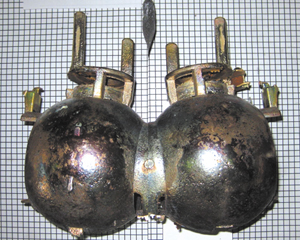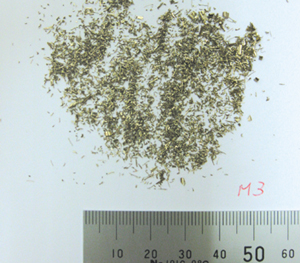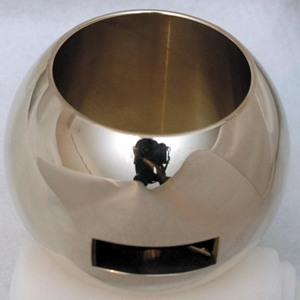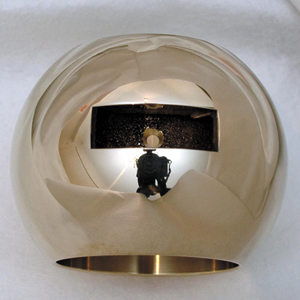T1 Test to check molten metal flow and trial production

Metal mold temperature approximately 95°C
Temperature during pouring about 1010°C
Molten metal flow is very good.
Molten metal sufficiently fills the mold up to up-hill part for degassing.
The run of the molten metal was about the same with fast and with slow flow of the molten metal supplied to the product part.
A defect was found in trial production caused by shrinkage in the part sandwiched by the core, which is the part that solidifies last.
We believe the defect can be resolved by using a different gate thickness and position.
T2 Teeter mold test

Result: Good It can be used for permanent mold casting
There is little internal shrinkage and large external shrinkage.
Color check indicated a large red stained area , and the texture was rough and sponge-like.
A plan that considers the rough textured part, such as where it solidifies last, must be used.
Molten metal temperature may not be suitable. A temperature range must be used that is suitable for permanent mold casting.
T3 Confirmation of mechanical properties
Tensile strength: 494 N/mm2 Degree of elongation: 40%
Greatly exceeds the standards for common brass and bronze materials.
T4 Analysis and confirmation of molten metal components
| Cu | Sn | Pb | Zn | Bi | Fe | Ni | Si | Cd | ||
|---|---|---|---|---|---|---|---|---|---|---|
| 1. | Standard value | 80.0Min | 0.25Max | 0.15Max | 12.0-16.0 | 0.5-1.5 | 0.15Max | 0.2Max | 3.8-4.2 | |
| 2. | Purchased materials | 80.93 | 0.02 | 0.05 | 13.8 | 0.95 | 0.05 | 0.01 | 4.15 | 9ppm |
| 3. | Before melting | 80.5 | 0.009 | 0.01 | 14.44 | 1.07 | 0.04 | 0.011 | 3.9 | 9ppm |
| 4. | At the time of test production | 81 | 0.009 | 0.01 | 13.86 | 1.06 | 0.04 | 0.012 | 4.02 | 7ppm |
Molten metal management is relatively easy
Attention to Zn depletion is required but no significant depletion was observed.
T5 Confirming processability

The impression is hard.
Chips are small.
Can be processed if the conditions are changed.
T6 Evaluation of pressure resistance of trial production
Result
This trial product was not perfect, but good results were obtained.Metal mold plan and casting condition have large effects on pressure resistance.
Preliminary trial production
Leakage was observed in all products in preliminary trial production.Leakage was observed at the part sandwiched by core sand that solidifies last.There was no leakage at the part in direct contact with the metal mold.
True trial production
It can be improved through thickness settings and the way molten metal flows based on the metal mold plan.After changing the plan and thickness setting of the product, the results in true trial production were good.
Results and evaluation


Metal mold castability is good.
It can also be used as a material for permanent mold casting.
Mass production through low-pressure permanent mold casting is possible but continued investigations of permanent mold casting conditions, such as suitable pouring temperature as well as metal mold temperature, are necessary.Mass production is easily possible in the present state if the permanent mold casting product is small.
If we can find a suitable metal mold plan and suitable permanent mold casting conditions, higher values of mechanical properties can be obtained compared to commonly used brass, and therefore we can expect a reduced weight of permanent mold casting products through reduced thickness.